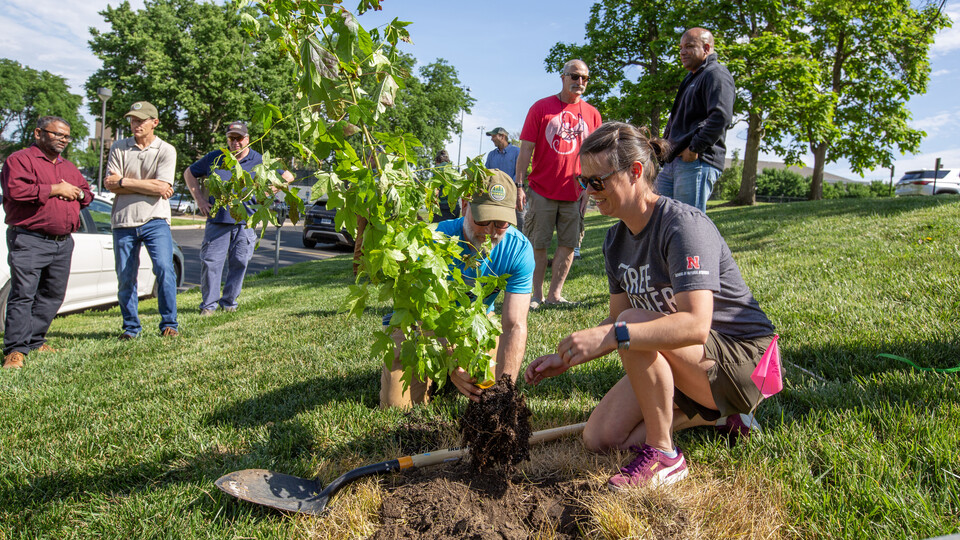|
|
|
In the above photo, Ann Powers, a lecturer in the UNL School of
Natural Resources, plants a sweetgum "Moon Tree" on UNL East Campus this week. The tree was
grown from a seed that flew around the moon three times as part of NASA’s Artemis I mission in
2022.
|
|
Happy Friday! A sweetgum tree that started from a seed that
recently flew to the moon and back, was planted on UNL East Campus earlier this week (true
story!). Ann Powers, a lecturer in the urban forestry program at UNL secured the tree from NASA
and organized the planting. You can learn more about this fun tree
here or
here, including the fact that it was grown in Nebraska at Bessey Nursery and that other
moon trees were planted as part of the Apollo missions in the 1970s. In honor of this
lunar traveler, we'll make sweetgum the Woody of the Week.
Woody of the Week: Sweetgum (Liquidambar styraciflua)
Grows 50-70' tall and 30-60' wide.
Native to much of southeast US.
Suitability: Marginally hardy in Nebraska and best suited to southeast counties.
Commonly named for the aromatic resin (gum) that exudes from its wounds.
Scientific name Liquidambar means just that - liquid amber, sap or resin that flows
from its wounds. Styraciflua also refers to fluid styrax, which is another name for
the resin.
Description (from
Missouri Botanical Garden): Liquidambar styraciflua, commonly called
sweetgum, is a low-maintenance deciduous shade tree that is native from Connecticut to Florida
and Missouri further south to Texas, Mexico and Central America. It typically grows to
60-80’ tall with a straight trunk. Habit is pyramidal in youth, but it gradually develops an
oval-rounded crown as it matures. The distinctive glossy, long-stalked, deep green leaves (4-7”
across) have toothed margins. Each leaf has 5-7 pointed, star-shaped lobes that somewhat
resemble maple leaves. Leaves are fragrant when bruised. Fall color at its best is a brilliant
mixture of yellows, oranges, purples and reds. Branchlets may have distinctive corky ridges.
Non-showy, female flowers give way to the infamous gum balls which are hard, spherical, bristly
fruiting clusters to 1.5” diameter. Gum balls mature to dark brown and usually remain on the
tree until late winter and can litter the ground in spring. This gumball "mess" often makes the
tree undesirable for general landscape use (I rarely see significant mess with Nebraska trees).
Sweetgums are best sited in moist soils and are not considered to be tolerant of extreme
drought. They do have some shade tolerance.
Nebraska is on the edge of viability for sweetgum but there are many nice specimens in Lincoln
and Omaha and other southeast towns. In fact Falls City and Nebraska City are home to many
fantastic trees where it's been commonly planted as a street tree for decades. We see
cold-weather dieback on some Nebraska trees, especially when they're young. I have a few
20year old specimens in the Waverly Arboretum and some had significant dieback the last
two years which could have been both drought-related and cold related. Because of the urban
heat island effect, some marginally hardy trees do better in Lincoln and Omaha than in nearby
smaller towns. As with many tree species, it's important to pay attention to the seed
source of a planted sweetgum in our area. Sweetgum has a wide natural range from the upper
Midwest south the the Gulf Coast, so choosing a tree originating from a northern seed
source, if known, would be wise.
Related Species: There are other sweetgum species in Asia including several tropical types. Few
are cultivated in North America. There are several named cultivars of the American sweetgum
including the striking 'Slender Silhouette' that's a columnar form; 'Moraine' which is thought
to be the most cold hardy; and 'Rotundiloba' which is a sterile cultivar with leaves that have
distinctly rounded lobes.
Fun Facts:
-
Other common names include storax, hazel pine, redgum
and alligator wood.
-
Sweetgum wood has been widely used for a number of
applications including flooring, furniture and home interiors.
-
The gum obtained from the sweetgum genus of plants has been
used in the past for a variety of purposes, including chewing gum, incense, perfumes, folk
medicines and flavorings.
-
Sweetgum is an ancient genus with fossil leaves of related
species going back millions of years.
|
|
|
The star-shaped leaves of sweetgum resemble a maple, but maples
have opposite leaves and buds while sweetgum's are alternate on the twig. Sweetgum
can have a kaleidoscope of fall color with leaves ranging from purple, to red, to orange
or yellow.
|
|
|
Lincoln (left) and Falls City (right) are home to many nice
sweetgum trees.
|
|
|
Sweetgum "gum balls" are the spiny seed balls that hang on the
tree in the winter and can litter the ground in the spring. The fruits contain up to 60
capsules of tiny paired seeds. When the winged seeds are released over winter, the gum ball is
marked by many noticeable holes where the seeds had been.
|
|
Justin Evertson, Green Infrastructure
Coordinator
Nebraska Forest Service & Nebraska Statewide Arboretum
402-472-6604 |
jevertson1@unl.edu
|
|
|
|
|

